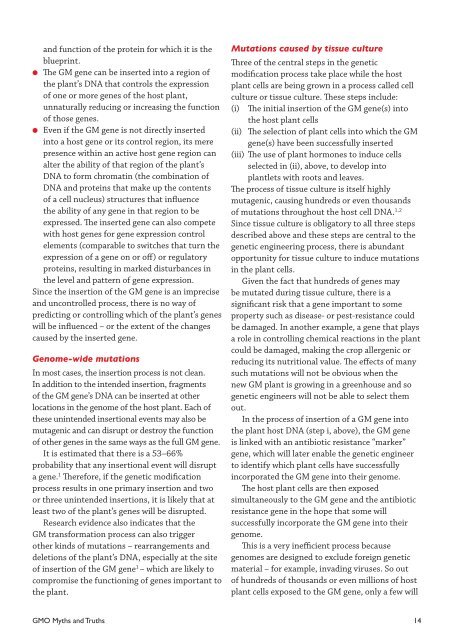GMO Myths and Truths
GMO Myths and Truths
GMO Myths and Truths
Create successful ePaper yourself
Turn your PDF publications into a flip-book with our unique Google optimized e-Paper software.
<strong>and</strong> function of the protein for which it is the<br />
blueprint.<br />
● The GM gene can be inserted into a region of<br />
the plant’s DNA that controls the expression<br />
of one or more genes of the host plant,<br />
unnaturally reducing or increasing the function<br />
of those genes.<br />
● Even if the GM gene is not directly inserted<br />
into a host gene or its control region, its mere<br />
presence within an active host gene region can<br />
alter the ability of that region of the plant’s<br />
DNA to form chromatin (the combination of<br />
DNA <strong>and</strong> proteins that make up the contents<br />
of a cell nucleus) structures that influence<br />
the ability of any gene in that region to be<br />
expressed. The inserted gene can also compete<br />
with host genes for gene expression control<br />
elements (comparable to switches that turn the<br />
expression of a gene on or off) or regulatory<br />
proteins, resulting in marked disturbances in<br />
the level <strong>and</strong> pattern of gene expression.<br />
Since the insertion of the GM gene is an imprecise<br />
<strong>and</strong> uncontrolled process, there is no way of<br />
predicting or controlling which of the plant’s genes<br />
will be influenced – or the extent of the changes<br />
caused by the inserted gene.<br />
Genome-wide mutations<br />
In most cases, the insertion process is not clean.<br />
In addition to the intended insertion, fragments<br />
of the GM gene’s DNA can be inserted at other<br />
locations in the genome of the host plant. Each of<br />
these unintended insertional events may also be<br />
mutagenic <strong>and</strong> can disrupt or destroy the function<br />
of other genes in the same ways as the full GM gene.<br />
It is estimated that there is a 53–66%<br />
probability that any insertional event will disrupt<br />
a gene. 1 Therefore, if the genetic modification<br />
process results in one primary insertion <strong>and</strong> two<br />
or three unintended insertions, it is likely that at<br />
least two of the plant’s genes will be disrupted.<br />
Research evidence also indicates that the<br />
GM transformation process can also trigger<br />
other kinds of mutations – rearrangements <strong>and</strong><br />
deletions of the plant’s DNA, especially at the site<br />
of insertion of the GM gene 1 – which are likely to<br />
compromise the functioning of genes important to<br />
the plant.<br />
Mutations caused by tissue culture<br />
Three of the central steps in the genetic<br />
modification process take place while the host<br />
plant cells are being grown in a process called cell<br />
culture or tissue culture. These steps include:<br />
(i) The initial insertion of the GM gene(s) into<br />
the host plant cells<br />
(ii) The selection of plant cells into which the GM<br />
gene(s) have been successfully inserted<br />
(iii) The use of plant hormones to induce cells<br />
selected in (ii), above, to develop into<br />
plantlets with roots <strong>and</strong> leaves.<br />
The process of tissue culture is itself highly<br />
mutagenic, causing hundreds or even thous<strong>and</strong>s<br />
of mutations throughout the host cell DNA. 1,2<br />
Since tissue culture is obligatory to all three steps<br />
described above <strong>and</strong> these steps are central to the<br />
genetic engineering process, there is abundant<br />
opportunity for tissue culture to induce mutations<br />
in the plant cells.<br />
Given the fact that hundreds of genes may<br />
be mutated during tissue culture, there is a<br />
significant risk that a gene important to some<br />
property such as disease- or pest-resistance could<br />
be damaged. In another example, a gene that plays<br />
a role in controlling chemical reactions in the plant<br />
could be damaged, making the crop allergenic or<br />
reducing its nutritional value. The effects of many<br />
such mutations will not be obvious when the<br />
new GM plant is growing in a greenhouse <strong>and</strong> so<br />
genetic engineers will not be able to select them<br />
out.<br />
In the process of insertion of a GM gene into<br />
the plant host DNA (step i, above), the GM gene<br />
is linked with an antibiotic resistance “marker”<br />
gene, which will later enable the genetic engineer<br />
to identify which plant cells have successfully<br />
incorporated the GM gene into their genome.<br />
The host plant cells are then exposed<br />
simultaneously to the GM gene <strong>and</strong> the antibiotic<br />
resistance gene in the hope that some will<br />
successfully incorporate the GM gene into their<br />
genome.<br />
This is a very inefficient process because<br />
genomes are designed to exclude foreign genetic<br />
material – for example, invading viruses. So out<br />
of hundreds of thous<strong>and</strong>s or even millions of host<br />
plant cells exposed to the GM gene, only a few will<br />
<strong>GMO</strong> <strong>Myths</strong> <strong>and</strong> <strong>Truths</strong> 14


